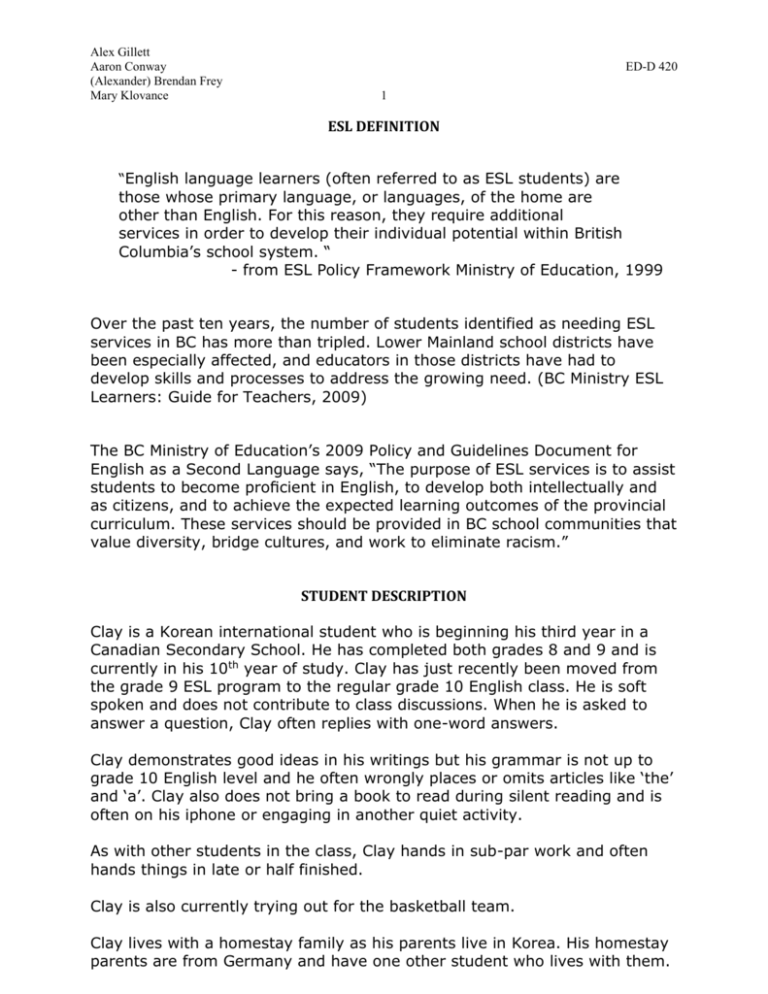Aaron edits 2
advertisement

Alex Gillett Aaron Conway (Alexander) Brendan Frey Mary Klovance ED-D 420 1 ESL DEFINITION “English language learners (often referred to as ESL students) are those whose primary language, or languages, of the home are other than English. For this reason, they require additional services in order to develop their individual potential within British Columbia’s school system. “ - from ESL Policy Framework Ministry of Education, 1999 Over the past ten years, the number of students identified as needing ESL services in BC has more than tripled. Lower Mainland school districts have been especially affected, and educators in those districts have had to develop skills and processes to address the growing need. (BC Ministry ESL Learners: Guide for Teachers, 2009) The BC Ministry of Education’s 2009 Policy and Guidelines Document for English as a Second Language says, “The purpose of ESL services is to assist students to become proficient in English, to develop both intellectually and as citizens, and to achieve the expected learning outcomes of the provincial curriculum. These services should be provided in BC school communities that value diversity, bridge cultures, and work to eliminate racism.” STUDENT DESCRIPTION Clay is a Korean international student who is beginning his third year in a Canadian Secondary School. He has completed both grades 8 and 9 and is currently in his 10th year of study. Clay has just recently been moved from the grade 9 ESL program to the regular grade 10 English class. He is soft spoken and does not contribute to class discussions. When he is asked to answer a question, Clay often replies with one-word answers. Clay demonstrates good ideas in his writings but his grammar is not up to grade 10 English level and he often wrongly places or omits articles like ‘the’ and ‘a’. Clay also does not bring a book to read during silent reading and is often on his iphone or engaging in another quiet activity. As with other students in the class, Clay hands in sub-par work and often hands things in late or half finished. Clay is also currently trying out for the basketball team. Clay lives with a homestay family as his parents live in Korea. His homestay parents are from Germany and have one other student who lives with them. Alex Gillett Aaron Conway (Alexander) Brendan Frey Mary Klovance ED-D 420 2 DESIGNATION For a student to be identified as an English language learner, an assessment of English language proficiency must be carried out. Initial assessments will typically be conducted upon a student’s first arrival at school but may be conducted at any point if there is an indication that there might be a need for ESL services. Initial assessment should be designed to gather information on the students: • English proficiency (or in the Conseil scolaire francophone de la ColombieBritannique, French proficiency: http://www.csf.bc.ca/) and experience in all areas of language development: listening, speaking, reading, and writing (representing and viewing may also contribute to assessment of language proficiency); • Previous schooling (e .g.,report cards if available; information on interruptions to schooling); • Language(s) and/or dialect(s) spoken at home; • Proficiency in his or her first language – listening, speaking, reading, viewing, writing, representing; where documentary evidence and information from parents are insufficient, assessment of a student’s first-language proficiency may be required, of available; • Basic language and content skills in academic subject areas (e .g ., mathematics); and • Possible needs other than ESL services (e .g . support services for special needs, trauma counselling, services of a settlement worker) . The assessment should be relevant to the student’s age, taking into account the student’s academic, cultural, and social/emotional needs. Assessment of English proficiency should consider cultural and linguistic diversity (for example, should avoid requiring cultural knowledge) and be nondiscriminatory. The assessment should also consider both the language performance and classroom functioning of the learner. Initial assessments of English language should include, but are not limited to a combination of the following approaches: • A test of English language proficiency; • Oral interviews (with students, parents); Alex Gillett Aaron Conway (Alexander) Brendan Frey Mary Klovance ED-D 420 3 • Reviews of students’ oral and unedited written language samples as appropriate • Assessments of students’ reading and listening comprehension Use of standardized tests can yield helpful information, but these should not be the sole basis for making an initial assessment A language proficiency assessment should be documented at least annually for English language learners to determine progress and eligibility for ESL funding. School districts may receive supplemental funding from the Ministry of Education for eligible students needing ESL or FLS support, and these students should be reported to the ministry as part of the Regular Enrolment report. Students are eligible for funding for up to five school years and must receive the service consistently throughout the ten months of each school year. INDIVIDUAL EDUCATION PLAN (IEP) SECONDARY STUDENT'S LAST NAME GIVEN NAMES Lee DATE OF BIRTH Clay __1996_/___07__/___24___ YY MM DD STREET ADDRESS CITY 3222 MacRae Ave Victoria GRADE PROVINCE BC POSTAL CODE NAME OF SCHOOL V8P 5G9 GUARDIANS Valentina and Chrisitian Supovatek FUNDING CATEGORY DATE ESTABLISHED March 22, 2011 10 MacRae Secondary HOME PHONE 250- 555-5555 WORK PHONE 778-555-5555 IMPORTANT MEDICAL/SOCIAL INFORMATION - No known medical issues Student does not socialize with non Korean speakers Quiet and Introverted during classroom discussions REVIEW DATE June 1, 2011 LONG TERM REVIEW June 25th, 2011 Alex Gillett Aaron Conway (Alexander) Brendan Frey Mary Klovance ED-D 420 4 CURRENT LEVEL OF PERFORMANCE ACADEMIC: Clay attends all subjects other than math inconsistently. In addition, Clay’s often late and incomplete classwork impoverishes his achievement below his true ability. Assessment reveals the following levels of proficiency: Writing Burnaby South Benchmarks rubric indicates a Level One Middle score (out of two) for writing ability Genre Analysis also suggests a low L2 score in writing Written Language Matrix (Richmond SD) indicates a Level 2 score (out of four) in writing Reading Comprehension (Woodcock) suggests an Developing category for reading ability (out of Emerging, Beginning, Developing, Expanding, Proficient, and Fluent). Oral Prototype Oral Interview (O’Malley, M & L Valdez-Pierce) suggests Developing category for speaking and listening (out of Emerging, Beginning, Developing, Expanding, Proficient, and Fluent). Analytic Oral Language Scoring Rubric also indicates Developing category. BEHAVIOUR: Clay is socially withdrawn from non-Korean speakers, thus far not involved in extracurricular activities SOCIAL: Clay’s parents are living in Korea. His homestay parents are busy and not involved in tracking homework progress at this time. CURRENT STRENGTHS Clay has above average math skills. Clay enjoys playing basketball and has attempted to try out for an extra-curricular activity. Clay is respectful of his peers and teachers. SUMMARY OF BASIC NEEDS Writing Clay needs to expand his vocabulary to better communicate his ideas. Clay needs to include logical sequence in his written works and fill in more detail to develop main ideas. Clay needs to include greater use of the three simple tenses (past, present, future). Alex Gillett Aaron Conway (Alexander) Brendan Frey Mary Klovance ED-D 420 5 Clay needs to include subordination as well as coordination in longer sentences. Clay needs to include missing words, reduce punctuation and capitalization errors, and eliminate sentence fragments. Reading Clay needs to work on reading English texts independently Clay needs opportunity to read aloud in independent and pull-out sessions. Clay needs to work on “reading between the lines” of the text he read (i.e. Clay must show the ability to draw appropriate inferences from the work). Oral Clay needs to work on sustaining conversations and initiating communication in the classroom. Clay needs to pre-think ideas to reduce the need for speech hesitations and rephrasing for greater fluency. Clay needs to increase the use of other tenses than the present and reduce errors of omission (leaving words out and endings off) to improve on structure. Clay needs to expand his vocabulary and minimize word usage errors. Clay needs to focus on classroom discussion, recognize when he is not understanding, and request rephrasing or repetition to improve his listening skills. LONG TERM OBJECTIVES Christopher will attend math and science classes. Christopher will develop a greater independence in the application of compensatory strategies for arithmetic operations and computations. Christopher will understand and be able to carry out operations involving regrouping, decimals, and fractions. GOALS, SHORT TERM OBJECTIVES AND INSTRUCTIONAL STRATEGIES Goal: Christopher will improve attendance and organization. Objective: Christopher will attend math and science class, and bring the appropriate materials with him. Strategies: Christopher’s parents will provide him with a different colored binder for each subject, and he will bring the appropriate one with him to class. Evaluation: Mrs Hoover will record Christopher’s attendance and communicate with his other teachers Goal: Christopher will improve his ability to perform arithmetic operations. Objective: Christopher will be able to translate arithmetic problems into words, and describe what needs to be done to find the solution. Strategies: Christopher will learn which symbols represent which arithmetic operations, and in which direction they are operating. Christopher will also be taught the CRA method (concrete-torepresentational-to-abstract) to help move Christopher from concrete to abstract problems. Alex Gillett Aaron Conway (Alexander) Brendan Frey Mary Klovance ED-D 420 6 Evaluation: Mrs Krebople will evaluate Christopher’s success using arithmetic operations on tests and assignments. Goal: Christopher will reduce the number of computational and place value errors in his work. Objective: Christopher will double-check his calculations before handing in assignments or tests. Strategies: Christopher will review his work from the bottom up, putting check marks next to steps he agrees with. Evaluation: Mrs Krebople will verify that Christopher is reviewing his work, and look for concepts with which Christopher is showing improvement and those which need more work. Goal: Christopher will add and subtract numbers, including decimals, using the column method Objective: Christopher will successfully add and subtract numbers, including decimals. Strategies: Christopher will use the column method to help organize addition and subtraction procedures. Evaluation: Mrs Krebople will decide whether using the column method helps Christopher with addition and subtraction by looking at his daily homework assignments and quizes. Goal: Christopher be able to regroup units into different powers of ten. Objective: Christopher will successfully add or subtract numbers by regrouping units. Strategies: In a pull-out session Christopher will practice regrouping using color tiles with Mr Largo. Evaluation: Mrs Krebople will verify proper use of regrouping to add or subtract numbers on tests and assignments. Goal: Christopher will confidently add and subtract numbers. Objective: Christopher will demonstrate addition and multiplication with base 10 blocks. Strategies: In a pull-out session Christopher will practice addition and multiplication with base 10 blocks with Mr Largo. Evaluation: Mrs Krebople will evaluate effectiveness of addition and multiplication on tests and assignments when Christopher is able to use base 10 blocks during the test. Goal: Christopher will understand and demonstrate place value in multiplication and division questions Objective: Christopher will use the explicit trade method of division and the lattice multiplication method. Strategies: In a whole class session these methods will be taught to all students and then during individual homework time, teacher will work to clarify process with Christopher. Christopher will show all work when doing these operations. Evaluation: Mrs. Kerbople will evaluate the effectiveness of these methods on homework assignments and if extra explanations are needed will suggest that Christopher will come spend a lunch time with Mrs. Kerbople. Goal: Christopher will be able to translate verbal, concrete, and written representations of fractions, and to use them in arithmetic operations. Objective: Christopher will be able to demonstrate his understanding of fractions using fraction tiles. Strategies: Christopher will learn which components of fraction tiles correspond to numerators and denominators, how to represent a fraction as a presentation of fraction tiles, and vice versa. He will then use fraction tiles to help with arithmetic operations. Evaluation: Mrs Krebople will verify Christopher’s ability to perform calculations with fractions on homework assignments, quizzes and tests. TEAM MEMBERS Alex Gillett Aaron Conway (Alexander) Brendan Frey Mary Klovance ED-D 420 7 TEAM MEMBER'S NAME POSITION/AGENCY ROLE 1. Mr. Horton Principal Approve IEP 2. Mrs. Parker English teacher 3. Ms. Ito Social Studies teacher 4. Mrs. Chiquita Homeroom teacher 5. Mary Tutor 6. Mr. & Mrs .Lee parents 7.Clay Lee student Use best practices for ESL learners in class. Communicate with parents. Provide in class adaptations when necessary. Use best practices for ESL learners in class. Communicate with parents. Provide in class adaptations when necessary. Record attendance and communicate between Clay’s teachers Help Clay with homework and oral and written English practice after school. Work with Clay at home (to the best of their ability) to ensure he is getting his homework done. Attend class, and participate in all activities. Do as much of his homework as he can, and attend extra English tutoring sessions after school. REFERENCES Beardsmore, Boe. Exploring ESL: specialist teacher preparation and professional development in British Columbia, UVic Master’s Thesis, 2008. Carrasquillo, A .L. and V. Rodriguez. 2002. Language minority students in the mainstream classroom (2nd ed.). Clevedon, England: Multilingual Matters. Ferguson, R. F. (2001). Cultivating new routines that foster high achievement for all students: How researchers and practitioners can collaborate to reduce the minority achievement gap. Education Research, 19(4), 34. Garnett, Bruce, An introductory look at the academic trajectories of ESL students, Department of Educational Studies, University of British Columbia, 2008. Wong-Fillmore, L. & Snow, C.E. (2000). What teachers need to know about language. Washington, DC: ERIC Clearinghouse on Language and Linguistics. ESL Learners: A Guide for Classroom Teachers www.bced.gov.bc.ca/esl/policy/classroom.pdf ESL Learners: A Guide for ESL Specialists www.bced.gov.bc.ca/esl/policy/special.pdf Alex Gillett Aaron Conway (Alexander) Brendan Frey Mary Klovance ED-D 420 8 About Teaching to Diversity: ESL, Learning Assistance, Special Education http://bctf.ca/IssuesInEducation.aspx?id=10568 ESL Teacher Professional Organizations http://www.bctf.ca/psas/ESLPSA/professional_organizations.html



![[1.1] Prehistoric Origins Work Sheet](http://s3.studylib.net/store/data/006616577_1-747248a348beda0bf6c418ebdaed3459-300x300.png)


